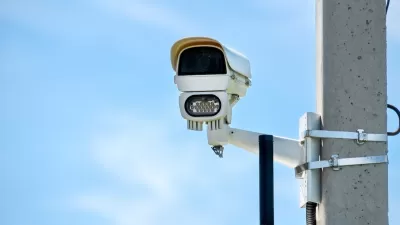Experts caution that blanket bans on right turns on red make only a slight contribution to reducing fatal crashes, and other interventions are needed to bring down traffic fatalities.

Banning right turns on red can reduce vehicle-pedestrian conflict, but “may not substantially address road safety challenges,” reports Michael Brady in Smart Cities Dive.
“Indeed, research shows that allowing right-turn-on-red leads to more conflicts between cars and pedestrians. For instance, permitting right-turn-on-red led to a 43% to 107% increase in pedestrian crashes and a 72% to 123% rise in cyclist crashes, according to a 1982 study by the U.S. National Highway Traffic Safety Administration.” However, these crashes tend to be minor and not a major contributor to traffic fatalities. Between 1982 and 1992, just 0.2% of roadway fatalities occurred at intersections with right turns on red allowed.
Experts suggest taking a more targeted approach by banning right turns only at particularly dangerous intersections to “get the most benefit at the lowest political and economic cost.”
Ultimately, right-turn bans must fit within a “bigger policy framework” that includes “[l]owering posted vehicle speed limits, instating traffic-calming measures, reducing permissive left turns and improving pedestrian and cycling infrastructure.”
FULL STORY: Right-turn-on-red bans not a ‘silver bullet’ for pedestrian safety, experts say

Planetizen Federal Action Tracker
A weekly monitor of how Trump’s orders and actions are impacting planners and planning in America.

Restaurant Patios Were a Pandemic Win — Why Were They so Hard to Keep?
Social distancing requirements and changes in travel patterns prompted cities to pilot new uses for street and sidewalk space. Then it got complicated.

Map: Where Senate Republicans Want to Sell Your Public Lands
For public land advocates, the Senate Republicans’ proposal to sell millions of acres of public land in the West is “the biggest fight of their careers.”

Maui's Vacation Rental Debate Turns Ugly
Verbal attacks, misinformation campaigns and fistfights plague a high-stakes debate to convert thousands of vacation rentals into long-term housing.

San Francisco Suspends Traffic Calming Amidst Record Deaths
Citing “a challenging fiscal landscape,” the city will cease the program on the heels of 42 traffic deaths, including 24 pedestrians.

California Homeless Arrests, Citations Spike After Ruling
An investigation reveals that anti-homeless actions increased up to 500% after Grants Pass v. Johnson — even in cities claiming no policy change.
Urban Design for Planners 1: Software Tools
This six-course series explores essential urban design concepts using open source software and equips planners with the tools they need to participate fully in the urban design process.
Planning for Universal Design
Learn the tools for implementing Universal Design in planning regulations.
Heyer Gruel & Associates PA
JM Goldson LLC
Custer County Colorado
City of Camden Redevelopment Agency
City of Astoria
Transportation Research & Education Center (TREC) at Portland State University
Camden Redevelopment Agency
City of Claremont
Municipality of Princeton (NJ)





























